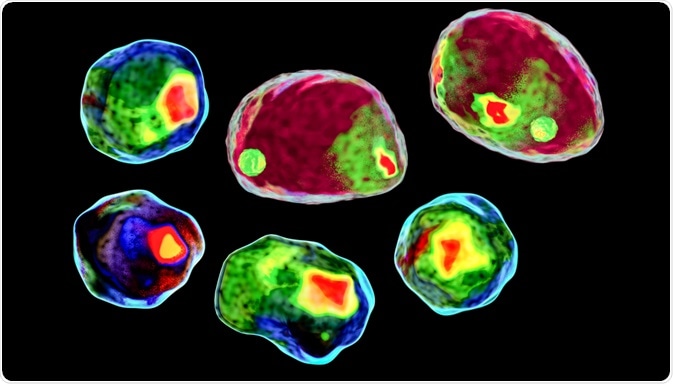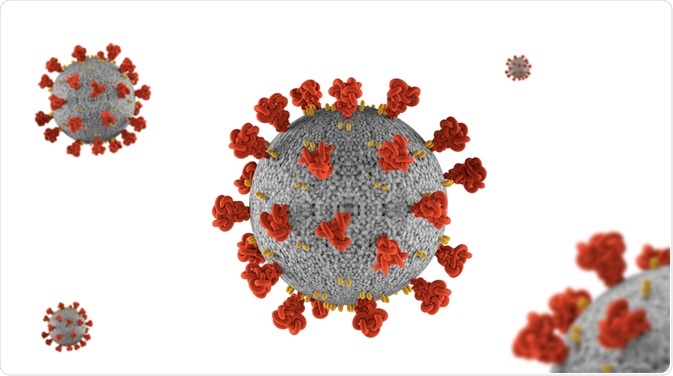Flow cytometry is a highly versatile tool that has applications across various fields of science, including bacteriology, immunology, infectious diseases, molecular biology, oncology, and virology. The application has vastly developed over recent decades, allowing cell biology and immune system studies to gain unprecedented levels of detail.

Flow Cytometry image of human cells. Image Credit: Kateryna Kon/Shutterstock.com
Here, we discuss the technique of flow cytometry along with its most recent and relevant applications in vaccine development and virology, particularly in relation to how it is being used to reduce the spread of the COVID-19 pandemic.
Flow cytometry: technique
Flow cytometry is an application that produces rapid, single-target readouts, multi-parametric analyses, complex subpopulation phenotyping, and cell signaling analyses. The flow cytometry method relies on the use of lasers as light sources that are shone onto samples of cell cultures. Light exposure to the sample produces signals in the form of scattered and fluorescent light.
Photodiodes or photomultiplier tubes are then used as detectors to register these signals which are converted into electric signals for analysis. Computer programs are used to analyze the signals and write the data in a standardized format. The light scattering or fluorescent characteristics of a sample are used to define and/or purify cell populations.
The flow cytometry method utilizes several fluorescent reagents, such as DNA binding dyes, fluorescent expression proteins, fluorescently conjugated antibodies, ion indicator dyes, and viability dyes.
Over recent decades, the equipment required to run flow cytometry analyses has significantly advanced. Systems that use multiple lasers are now commonplace. In addition, many varieties of flow cytometry systems have evolved to meet specific purposes, such as systems with 96-well loaders that have been developed for bead analysis. Finally, advancements to equipment have allowed flow cytometry to be combined with other, complementary technologies, such as microscopy techniques or mass spectrometry.
Continued developments in flow cytometry are vital to furthering the various disciplines which have applications for the technology. Fields such as bacteriology, immunology, infectious diseases, molecular biology, oncology, and virology all leverage the flow cytometry technique and stand to benefit from its continued advancements.
The study of the immune system and its role in cancer and infectious diseases, for example, frequently utilizes flow cytometry to simultaneously characterize cells in samples of mixed populations. The method allows for cell populations taken from blood, bone marrow, and solid tissues to be split into single cells such as lymph nodes, mucosal tissues, solid tumors, spleen, and more. Flow cytometry allows cells to be sorted for further analysis, a capability that is vital not only in cancer research but in numerous disciplines.
Using flow cytometry in the fight against COVID-19
Creating tests
At the beginning of the COVID-19 pandemic, research teams around the world were under significant pressure to construct effective and rapid testing options to detect the presence of the new virus in various sample types. Flow cytometry-based methods quickly emerged as an alternative testing method to those that were first available on the market.
Scientists have demonstrated that flow cytometry can be effectively leveraged to create COVID-19 tests. The COVID-19 virus is made up of a 29–30 kb chain of positive single-stranded RNA and measures just 70 to 90 nm. The dengue virion, measuring 40–60 nm, can be detected via combining fluorescently labeled antibodies with magnetic nanoparticles (MNPs).
At the end of 2020, a team of researchers in Mumbai adapted the methodology used to detect the dengue virion, labeling the surface of the COVID-19 particle with antigen-specific primary antibodies and adding a secondary antibody conjugated to a fluorescent dye.

COVID-19. Image Credit: GEMINI PRO STUDIO/Shutterstock.com
Vaccine development
In addition to developing new COVID-19 tests, flow cytometry has also been fundamental in the development of COVID-19 vaccinations. In 2020, COVID-19 researchers based in California at the Center for Infectious Disease and Vaccine Research, La Jolla Institute for Immunology, published positive findings demonstrating their use of flow cytometry panels to establish the immunological cellular profile of patients who had recovered from COVID-19 infection.
The team in California recognized that CD3+ cell frequencies showed a marginal increase in those who had recovered from COVID-19 in comparison to those who had not contracted the virus. Their results also showed that CD19+ cell frequencies were slightly decreased in the patient population. This evidence was a vital step to enabling researchers to gain a deeper understanding of how COVID-19 infection activates the human immune response, knowledge which is key to the development of effective vaccinations.
Conclusion
Overall, flow cytometry is a technique that, while it has been around for decades, is constantly developing and being leveraged into new applications across multiple disciplines. Interest in flow cytometry will likely continue, given its significant impact on the development of vaccines and its use in cancer research among others.
Sources:
- De Rosa, S., 2012. Vaccine applications of flow cytometry. Methods, 57(3), pp.383-391. https://www.ncbi.nlm.nih.gov/pmc/articles/PMC3349786/
- Grifoni, A., Weiskopf, D., Ramirez, S., Mateus, J., Dan, J., Moderbacher, C., Rawlings, S., Sutherland, A., Premkumar, L., Jadi, R., Marrama, D., de Silva, A., Frazier, A., Carlin, A., Greenbaum, J., Peters, B., Krammer, F., Smith, D., Crotty, S. and Sette, A., 2020. Targets of T Cell Responses to SARS-CoV-2 Coronavirus in Humans with COVID-19 Disease and Unexposed Individuals. Cell, 181(7), pp.1489-1501.e15. www.cell.com/.../S0092-8674(20)30610-3
- McKinnon, K., 2018. Flow Cytometry: An Overview. Current Protocols in Immunology, 120(1). https://www.ncbi.nlm.nih.gov/pmc/articles/PMC5939936/
- Soni, N., Pai, P., Krishna Kumar, G., Prasad, V., Dasgupta, S., and Bhadra, B., 2020. A flow virometry process proposed for detection of SARS-CoV-2 and large-scale screening of COVID-19 cases. Future Virology, 15(8), pp.525-532. https://www.ncbi.nlm.nih.gov/pmc/articles/PMC7434223/
Further Reading
Last Updated: Mar 18, 2021